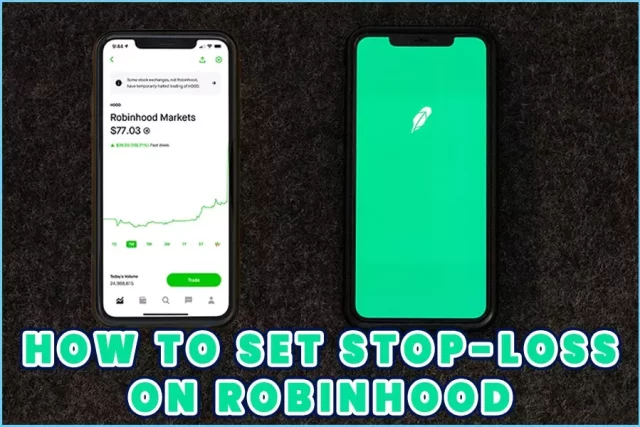Investing in securities and cryptocurrency is mainstream. Technology empowers us to trade in securities from the comfort of our homes.
Robinhood is one of the most popular investing platforms. It provides users with the option to trade in several securities commission-free.
There are many ways to limit your losses. The most popular way of protecting your money is using a stop-loss.
A stop-loss sells the security once its value drops to a certain price. By selling it at the stop-loss price, you can curb losses on your investment.
How To Set Stop-Loss In Robinhood
Robinhood makes it easy for users to place stop-loss orders on their investments. Part of the reason why the platform is popular is that it is easy to use. The User Interface is simple to understand.
How do you set stop-loss?
For iPhone Users:
Step 1: Open the Robinhood app on your device.
Step 2: Swipe to the bottom to see your list of securities.
Step 3: Tap the stock you want to minimize losses.
Step 4: On selecting the stock, go to the bottom right corner and tap the ‘Trade’ option.
Step 5: Tap ‘sell’
Step 6: Choose the currency you want to receive when you sell your security. You can find the currency options in the top-right corner.
Step 7: Under ‘conditional order,’ you will see a list of options for security. Tap ‘Stop Order’ just below ‘Limit Order.’
Step 8: Tap ‘Continue’
Step 9: Enter the Stop Price. The stop price should always be lower than the original investment value. It is because trading can never be completely risk-free.
The One Day Trading option applies if you wish to hold the security for only 24-hours. The Stop-loss on 90 days option applies if you wish to hold a security for more than one day.
After selecting the price, tap ‘Continue.’
Step 10: Choose the number of shares you want to apply to the ‘Stop Order.’
Setting Stop-Order on Android
Step 1: Launch the Robinhood app on your mobile device.
Step 2: Scroll down to view your list of securities.
Step 3: Tap the stock you on which wish to reduce your losses.
Step 4: After choosing a stock, go to the bottom right corner and hit the ‘Trade’ button.
Step 5: Press the sale button.
Step 6: Select the currency you wish to receive when selling your security. The currency selections are in the upper-right corner.
Step 7: You will find a range of security alternatives under’ conditional order. Just underneath ‘Limit Order,’ tap ‘Stop Order.’
Step 8: Press the ‘Continue’ button.
Step 9: Type in the Stop-Price. The cutoff price should never be higher than the initial investment value.
If you want to hold the security for 24 hours, you may use the One Day Trading option. If you want to hold a security for longer than one day, choose the Stop-loss on 90 days option.
After you’ve decided on a price, click ‘Continue.’
Step 10: Choose the number of shares you want to apply to the ‘Stop Order.’
Setting Up Stop-Loss On PC
Step 1: Log in to your Robinhood account on your PC through your browser.
Step 2: Open the navigation tools. Tap the three dots on the top-right corner.
Step 3: Select the ‘Stop-Price’ option.
Step 4: Select the amount
Step 5: Choose the Stop-Price amount.
Step 6: Enter the Stop Price. The stop price should always be lower than the original investment value. It is because trading can never be completely risk-free.
The One Day Trading option applies if you wish to hold the security for only 24-hours. The Stop-loss on 90 days option applies if you wish to hold a security for more than one day.
After selecting the price, tap ‘Continue.’
Step 10: Select the number of shares you wish to apply to the ‘Stop Order.’
Why Do You Need To Use Stop-Loss Orders
Many investors use Stop-Loss orders to protect themselves from excess losses. Though investing in most securities is not risk-free, you do not have to suffer great losses.
Stop-loss orders have the following benefits:
1. Free to Implement
You would normally have to pay some fee for many loss mitigation strategies. Stop-loss allows you to prevent excessive losses for free.
There are no costs when implementing your Stop-loss. Once you have set your stop-loss amount, it gets executed without a fee.
Stop-loss is even better on platforms like Robinhood. There are no commission charges when the auto-sell happens.
It is one of the best loss prevention strategies for new investors.
2. Insurance
Stop-loss works as insurance for your investment. The only difference is that it is free. You do not pay premiums to keep your stop-loss active.
Stop-loss insulates your investment and protects your money. It takes away the stress of worrying about your investment.
Not many trade opportunities provide the same level of protection from loss. Using stop-loss makes investing in securities less risky.
It is a great way to invest in non-risk-free securities.
3. No need for constant monitoring
A great advantage of stop-loss is that you do not have to keep track of your investments. It gives you peace of mind because you get assured that your securities are safe.
You can place your investments and the stop-loss percentage and go without checking the account. It is convenient if you do not understand how to do prediction and analysis.
You also don’t have to worry about volatile securities.
4. Diversify your portfolio
Stop-loss gives you a safe option to take on more investment. It provides the security you need to explore new markets.
You can try new securities without worrying about major losses. It also helps you learn how particular stocks behave.
Stop-loss is a great way of investing in risky securities that could potentially do well. It also helps you hedge against market risks.
5. Automatically Executed
Stop-loss happens automatically. It is convenient for the investor.
It saves you from excess losses. You will receive a notification from Robinhood.
There are no other steps required once you set your stop-loss limit.
Disadvantages Of Using Stop-Loss
While stop-loss is convenient and easy to execute, it has some disadvantages. The auto-sell setting is great for preventing losses. Here are some reasons why you should not use Stop-loss:
Short term fluctuations
Some stocks dip and rise during a trading period. It is normal for stock prices to move up and down. It is not a given that you will suffer losses if the prices fall.
If you set a low stop-loss percentage, you will suffer unnecessary losses. It is because stocks often recover from temporary dips.
The stock prices get influenced by the business cycle. Troughs and peaks are part are common. You might forgo great profits in the long-term by selling stock because of temporary dips,
Arbitrary Stop-loss Percentage
A stop-loss percentage is the value of a loss on the initial investment you are willing to take. These percentages vary depending on the investor’s attitude.
Risk takers have a high stop-loss percentage. Risk-averse investors usually set a Stop-loss at 5%.
There is no guideline on the stop-loss percentage. Most investors use their judgment to estimate a reasonable stop-loss percentage.
There is no proven official guideline on the appropriate stop-loss level. If your percentage is too high, you might suffer higher losses. If the percentage is low, you might forgo long-term profits.
Some securities lack the Stop-loss option.
Not all securities allow you to place a stop-loss option. Most securities are flexible enough to accommodate stop-loss.
Some securities are inherently volatile. It isn’t easy to accept a stop-loss limit. Some trading platforms also limit the number of securities you can set a Stop-loss.
Securities without Stop-loss options may be attractive, but most investors tend to be risk-averse. You cannot invest in such securities without exposing your capital to market risks.
Limit Orders
Limit orders are express agreements. Under limit, orders work like future rate agreements. The buyer agrees to buy a security at a fixed price. The difference between futures and limit orders is that the date is not predetermined.
Limit orders are not contractual agreements. You can choose to remove your limit order at any time.
Limit orders are great because they enable investors to buy a security at a discount. The limit orders are automated once the security falls to a certain price.
Conclusion
Investing in securities and cryptocurrencies is now commonplace. We may now trade securities from the comfort of our own homes thanks to advances in technology.
One of the most popular investment sites is Robinhood. It allows users to trade in various securities without paying any commissions.
There are several methods for limiting your losses. The most common technique to protect your money is to use a stop-loss order. A stop-loss sells the security if its value falls below a set amount. You can limit your investment losses by selling it at the stop-loss price.














